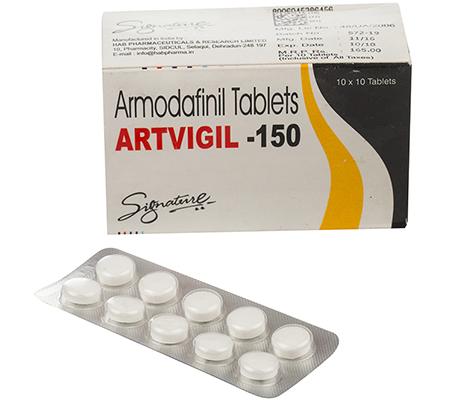Artvigil (Armodafinil) is a medication that promotes wakefulness and is used to treat excessive sleepiness caused by sleep apnea, narcolepsy, or shift work sleep disorder. Armodafinil may also be used for purposes not listed in this medication guide.
You should not use Artvigil if you have ever had a rash or allergic reaction caused by Armodafinil or Modafinil. Stop taking Artvigil and call your doctor if you have a skin rash, no matter how mild. Other signs of a severe reaction include fever, swelling in your face or tongue, mouth sores, trouble breathing, swelling in your legs, yellowing of your skin or eyes, and skin rash or blistering sores.
To make sure Artvigil is safe for you, tell your doctor if you have ever had: liver or kidney disease; a heart muscle or valve disorder such as mitral valve prolapse; high blood pressure, heart disease, or prior heart attack; mental illness or psychosis; or drug or alcohol addiction.
It is not known whether Artvigil will harm an unborn baby. Tell your doctor if you are pregnant or plan to become pregnant. Use a barrier form of birth control (condom or diaphragm with spermicide). Hormonal contraception (birth control pills, injections, implants, skin patches, and vaginal rings) may not be effective enough to prevent pregnancy during your treatment. It is not known whether Artvigil passes into breast milk or if it could affect the nursing baby. Tell your doctor if you are breast-feeding.
Artvigil is not approved for use by anyone younger than 17 years old.
Follow all directions on your prescription label. Do not take Artvigil in larger or smaller amounts or for longer than recommended. Armodafinil may be habit-forming. Never share Artvigil with another person, especially someone with a history of drug abuse or addiction.
Read all patient information, medication guides, and instruction sheets provided to you. Ask your doctor or pharmacist if you have any questions.
Artvigil is usually taken each morning to prevent daytime sleepiness, or 1 hour before the start of a work shift to treat work-time sleep disorders. Artvigil is usually given for up to 12 weeks. Follow your doctor's instructions.
If you are taking Artvigil to treat sleepiness caused by obstructive sleep apnea, you may also be treated with a continuous positive airway pressure (CPAP) machine. This machine is an air pump connected to mask that gently blows pressurized air into your nose while you sleep. The pump does not breathe for you, but the gentle force of air helps keep your airway open to prevent obstruction.
Do not stop using your CPAP machine during sleep unless your doctor tells you to. The combination of treatment with CPAP and Artvigil may be necessary to best treat your condition.
Taking Artvigil does not take the place of getting enough sleep. Talk with your doctor if you continue to have excessive sleepiness even while taking Artvigil. Armodafinil will not cure obstructive sleep apnea or treat its underlying causes. Follow your doctor's instructions about all your other treatments for this disorder.
Take the missed dose as soon as you remember, but avoid taking Artvigil if you do not plan to be awake for several hours. If it is close to your normal bedtime hour, you may need to skip the missed dose and wait until the next day to take the medicine again. Talk with your doctor about what to do if you miss a dose of Armodafinil. Do not take extra medicine to make up the missed dose.
Overdose symptoms may include nausea, diarrhea, confusion, feeling restless or excited, fast or slow heart rate, chest pain, trouble sleeping, or hallucinations (seeing or hearing things that are not real).
Get emergency medical help if you have signs of an allergic reaction (hives, difficult breathing, swelling in your face or throat) or a severe skin reaction (fever, sore throat, burning in your eyes, skin pain, red or purple skin rash that spreads and causes blistering and peeling). Skin rashes serious enough to require hospitalization have occurred in people using a medicine similar to armodafinil. These rashes usually occurred within 1 to 5 weeks after the first dose.
Stop taking Artvigil and call your doctor at the first sign of any skin rash, no matter how minor you think it might be.
Seek medical treatment if you have symptoms of a serious drug reaction that can affect many parts of your body. Symptoms may include: skin rash, fever, swollen glands, flu-like symptoms, unusual bruising, or jaundice (yellowing of your skin or eyes).
Stop using Armodafinil and call your doctor at once if you have: bruising, severe tingling, numbness, pain, muscle weakness; unusual bleeding (nosebleeds, bleeding gums); skin sores or blistering; mouth sores, trouble swallowing; chest pain, uneven heart beats; or depression, anxiety, hallucinations, aggression, unusual thoughts or behavior, suicidal thoughts.
This is not a complete list of side effects and others may occur. Call your doctor for medical advice about side effects.






